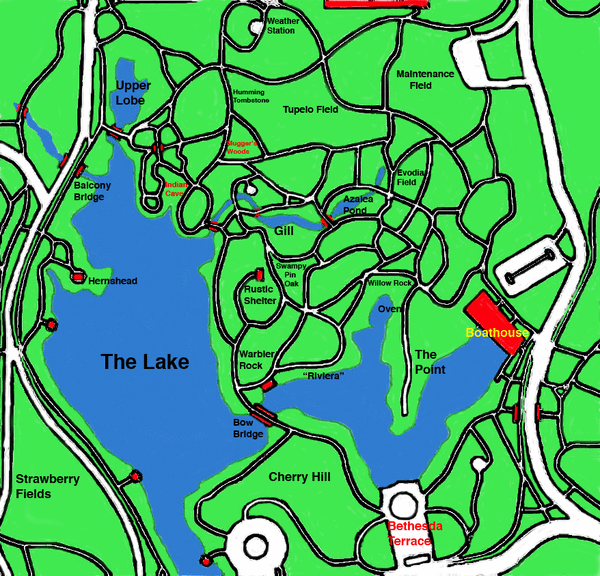

Central Park Birding:: the Ramble
The Google satellite map shows a the basic layout. This image was taken during the summer when even the Lake and Turtle Pond are greenish from duck weed and algae. The Ramble is in the area bounded by the 79th Street traverse to the north, Terrace Drive to the south, and the Park Drives to the east and west. The blue label "The Lake" is right over the Ramble itself - the Lake actually forms the southern and western borders to the Ramble. You can see that apart from the grassy areas at the Maintenance Field and the Tupelo Field the canopy is mostly continuous over the entire Ramble and in many areas is quite dense.
There is a considerable tangle of paths that criss-cross the Ramble, to the extent that it's likely you will get lost there until you learn the basic geography. Nevertheless the Ramble is not particularly large, so it's not that difficult to set yourself right.
Below is a clickable map of the Ramble - it's not a perfect thing, and I continue to develop it, but it will give you an idea of the basic layout. Paths are in white, water features in blue, structures including bridges/arches and buildings/gazebos are in red. The labels on the map are the birder names for locations, by no means a complete list but all the most prominent ones are there. If you click on the name it should send you to the description area further down in the text.

Below is a list of some of the more popular named places within the Ramble, but you shouldn't assume more anonymous places are any less productive. Almost any migrant passerine can be found almost anywhere, although they are often easier to find in locations like the Maintenance Field, Azalea Pond or the Oven where there are advantagous vantage points. When chasing a rare bird, people often make reference to these places so it's a good idea to have a basic concept of where the various features are, especially since you're not going to see signs to Warbler Rock anywhere within the Ramble.
 |
Azalea Pond - although the water flow is artificial and is controlled with a tap/faucet, the warblers that flock to this location don't care one bit about how it was made. At the eastern end of the Azalea Pond, its source, you can often see all sorts of warblers, tanagers and other passerines coming down to drink and bathe. I've seen Golden-winged Warbler here, Connecticut Warbler in fall 2005 just up the slope from here, and all sorts of interesting birds have been seen in the tall trees that surround it. A pair of Mallards sometimes try to nest in the middle of the pond, but usually get flooded out. In spring the flowering azaleas can be spectacular. The Central Park Conservancy has been spending quite a lot of time in recent years restoring the area - the fencing and their efforts have really improved the habitat. |
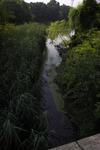 |
Balcony Bridge - runs over a small stream that feeds into the western shore of the Lake. Balcony Bridge is technically not in the Ramble but is on the busy West Park Drive adjacent to it. The stream that runs underneath is good for both waterthrushes, Rusty Blackbird, and perhaps something rarer like Sora - this bird has appeared twice here in Septembers past but is not annual. The Conservancy widened and deepened this area in recent years (2009?) so now it's nowhere near as good for Rusty Blackbirds or Solitary Sandpipers and all the phragmites have been removed (so no Sora, either). |
 |
Loeb Boathouse - at the eastern shore of the lake. You'll see only the commonest birds here, but this location holds two attractions: the sightings folder in which some birders record their sightings - it is located in the cafe section in a white binder; the cafe section which has quite decent food for breakfast and lunch. There are restrooms at the south end of the building. This is a natural gathering place for birders in the late morning, and many sightings are exchanged here by word of mouth. |
 |
Bow Bridge - a low long bridge that connects the Ramble to Cherry Hill. It is the major southern entrance to the Ramble. The western edge of the Ramble, just as you exit the bridge and running up the shore of the lake is often excellent for warblers, but here the canopy is at it's highest so it's often tough to get a good look at them. The small scrubby area right at the northern end of the bridge is often productive for warblers at a more reasonable elevation. The Conservancy is currently doing phragmites abatement in this area and the Mute Swans that formerly nested here have either passed on or moved on. |
 |
Evodia Field - a slightly more open area of the Ramble just to the east of Azalea Pond. In fact it doesn't resemble a field at all, but the slightly broken canopy in this vicinity promotes a little more understory growth. Apart from good vantage points for warblers in the canopy tops of the adjacent trees, the Evodia Field is most notable for the feeders, present every winter, which attract an array of commoner birds (White-throated Sparrows, Dark-eyed Juncos, Titmice, Chickadees and Goldfinches) as well as the occasional rarer visitor (Common Redpoll, Pine Siskin). The benches on the south end of the field make for a leisurely way to wait for something interesting to turn up. The Evodia Field is perhaps the single best location to find Ovenbird within the Ramble, given the density of the cover, and is also a good location for thrushes, particularly on it's western edge where the fruiting trees attract good numbers of them in September. |
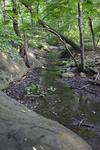 |
the Gill - this is the major water course flowing through the Ramble, from the outflow of the Azalea Pond down into the Lake. Louisiana and Northern Waterthrushes and Rusty Blackbirds can be found foraging along the stream, but it brings all sorts of passerines down out of the trees to bathe and drink so pretty much anything can be found here. A Saltmarsh Sharp-tailed Sparrow was found along here in April 2001. I've seen Cape May and Worm-eating Warblers bathing right in front of me at this location. The best section is from the west end of Azalea Pond to just north of the small wooden bridge (Laupot Bridge). |
| Hernshead - not in the Ramble, but often cited by birders in this general vicinity. Hernshead is a small promontory that juts into the western shore of the Lake. Its tall trees are often good in spring migration, and warblers that prefer a wetter environment are often found here - Yellow Warbler is the most obvious one, but Prothonotary Warbler has been found here in recent years. Ruby-throated Hummingbirds, Northern Waterthrush and particular Common Yellowthroat love the small wet area on the south shore with it's dense cover. Hernshead is also a vantage point for the outlet of the stream that runs underneath Balcony Bridge, and sometimes you can see sandpipers from here. Many ducks congregate here in winter (where they tend to get fed) or across the other side of the Lake at the mount of the Gill. | |
 |
Humming Tombstone - at the western end of the Tupelo Field. It's not a tombstone and it doesn't hum all that much - it's really a power distribution center for the footpath lighting. The tall trees around this location can hold many warblers on migration. The knotweed that used to dominate this area was good for Hooded Warbler and Mourning Warbler but has been reduced in extent in the last couple of years as the Conservancy "improves" the area (by improve I infer decimate). This area is also a crossroads for paths to the Upper Lobe (west), Belvedere Castle (north), Tupelo Field (east) and Mugger's Woods (south). |
| Indian Cave - this is a small inlet into the west side of the Ramble along it's western boundary with the Lake. The cave itself is blocked off, but the narrow canyon is sometimes a good place to find things like waterthrushes, thrushes and perhaps an American Woodcock. The surrounding area is good for warblers. The best vantage point is from the paths that run around the north/east corner of it and connect with the Lake shore on the west side of the Ramble and the Upper Lobe. | |
 |
the Lake - the western and southern boundary of the Ramble. The shoreline holds herons, egrets, waterthrushes and sandpipers, while the water attracts ducks in early winter and spring. The Mute Swans that formerly nested here are no longer to be found. Most of the real action in the Ramble is away from the Lake and up in the canopy - but wet areas bordering the Lake like the Oven are always good bets. |
 |
Maintenance Field - this is the other area in the Ramble with a major break in the canopy, along with the Tupelo Field (nearby). The open area is bounded on three sides by an array of trees. The western edge catches the early morning sun, and like other peripheral areas in the Ramble has a reputation for attracting early morning concentrations of warblers. The trees to the eastern edge which line the parking lot are every bit as good, but the light is usually trickier. On good days there can be congregations of up to 50 birders in the Maintenance Field looking at interesting birds. Nearly every species can be seen there, my personal highlights being a Lawrence's Warbler in April 2004 and two Black-billed Cuckoos at the same time in fall of 2003. Palm Warblers, Northern Flickers and various sparrows feed in the grass in fall and spring, sometimes joined by Scarlet Tanagers. The dense foliage on the western edge attracts thrushes, Common Yellowthroats and wrens, and a Mourning Warbler or two. Eastern Phoebes and Empidonax flycatchers can be found hunting along the edges or further up into the canopy. This is usually the location that I start birding in on the mornings when I bird the Ramble because of its reputation as a good vantage point for migrants. Be sure to check the trees around the parking lot on the eastern edge too, since these also can be excellent. There are restrooms in the Rambles Shed at the northern edge of the Maintenance Field. There's a water fountain just to the east of the parking lot that may well be the only one in the Ramble. The Maintenance Field is just east of Iphigene's Walk. |
| Mugger's Woods - not actually the haunt of muggers any more but the former extensive cover in this vicinity might give you an idea of how it gained it's name. Birds like Hooded and Mourning Warblers are fond of skulking in the extensive understory of this area, which lies just to the south-east of the Tupelo Field. The trees along the eastern and northern boundaries, in particular, are your best bets for other warblers but the light is often non-optimal for viewing them in the morning light - usually the Tupelo Field gives you better vantage points. | |
 |
Oven/Willow Rock - this area bears two names but is basically the same location. The Oven is a small inlet on the north shore of the Lake, overgrown by willows and silted up, that is a reliable location to find warblers. Willow Rock is the rock ledge on the western edge of the Oven. The willows themselves have taken a shellacking from hurricanes and unseasonable snow storms and are in danger of dying off. The tall trees to the west of Willow Rock are good for canopy birds, but the willows themselves bring all sorts of warblers and other passerines down to drink. Nothern Waterthrush and Common Yellowthroat are reliable here. Herons and Egrets are often to be found foraging along the shore. During late winter American Woodcock are often found in the Oven. A Nelson's Sharp-tailed Sparrow is one of the more unusual birds to be found here (Sept 2002). The best place to overlook the Oven is from the west on Willow Rock itself, which also gives you a view down the western side of the Point. |
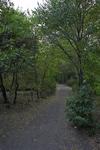 |
The Point - a single large promontory sticking into the Lake. The canopy tends to be lower down the point, bringing the warblers close to you, and the very tip of the point can be swarming with birds on good migration days. Common Grackles usually breed near the tip of the Point. You could find pretty much any warbler in this location, including Mourning Warbler in the areas with more cover. Olive-sided Flycatchers sometimes hunt from the dead snags about half-way down the Point. |
 |
Riviera - somewhat facetiously named because this is probably the warmest location in the Ramble in winter, when the sun illuminates the footpath along the north shore of the Lake. During migration the trees along the Lake shore often attract good numbers of warblers, while herons, egrets, waterthrushes and Swamp Sparrows can usually be found rummaging around on the shoreline. The Riviera connects Willow Rock to Bow Bridge, and attracts much the same species as these two locations. |
 |
Rustic Shelter - aka the Summer House is a large wooden construction just to the west of the Swampy Pin Oak. It's often occupied by the homeless, who have nevertheless never caused me any problems. The Rustic Shelter is a good marker for birds seen on the western slopes of the Ramble rather than a location in it's own right. |
| Swampy Pin Oak - a small area to the east of the Rustic Shelter. The massive Pin Oak dominates this section and is a major attraction for typical "nose-bleed" warblers in migration (Tennessee, Blackburnian etc). The cover underneath it, often wet, draws birds like Northern Waterthrush, Brown Thrasher and Eastern Towhee. The big Pin Oak itself suffered its final demise courtesy of Hurricane Sandy and the Nor'easter the following week in fall 2012, along with a couple of surrounding trees. The area has therefore opened up a little and although it lacks the large warbler magnet it might still prove to be very good in migration. | |
 |
Tupelo Field - this is one of the few areas in the Ramble with an large break in the canopy. The open area is bounded with an array of trees that are warbler magnets. One of these, the Tupelo itself, sports magnificent fall foliage in October. In addition it also attracts quite an array of thrushes and Eastern Phoebes at the right time of year. In May 2004 a very cooperative Mourning Warbler spent a few days scavenging in the grass a little west of this tree, although a more typical warbler in this location would be a Palm Warbler. The field extends from the "Humming Tombstone" to the west all the way over to an area that borders the Evodia Field, and is the most extensive grassy area within the Ramble. My life Mourning Warbler was on the eastern edge of the Tupelo Field, as was my first Mourning Warbler of 2005. |
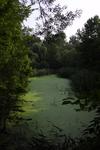 |
Upper Lobe - this is a shallow area that is the most north-western extension of the Lake, although the stream to the Lake is mostly silted up now. Green Herons have previously bred here. Northern Waterthrushes can often be found rummaging near the bridge. Yellow Warblers and other wood warblers can be found in the surrounding willows and other tall trees. My park Golden-winged Warbler was in the tall deciduous trees at the north end of the Upper Lobe. The Conservancy likes to call this small patch of water Bank Rock Bay but there's nothing bay-like about it. By extension the bridge is Bank Rock Bridge. There's been some deepening of this area in recent years, although not generally to the benefit of the wildlife. However the Conservancy have replanted the eastern bank - formerly heavily worn - and this is now very productive migrant habitat. |
| Weather Station - actually sits at the top of the rise that leads to Belvedere Castle. The wooded area between the two paths that lead down from Belvedere have much the same birds found in other parts of the Ramble, but sometimes you will run into roving flocks of warblers making their way from Turtle Pond. Birds like Yellow-breasted Chat are sometimes found in this vicinity. The canopy also tends to be closer to eye level here, making it easier to see a few birds. David Speiser and myself found a Kentucky Warbler on the western slope of this area in spring 2004. More typically it's a good place to find birds like Ovenbird. The two paths down from the weather station lead to the Tupelo Field (either the Humming Tombstone or right toward the Tupelo itself). | |
| Warbler Rock - this raised rocky area overlooks the trees on the west side of the Ramble. The major advantage of this location is that it puts you much closer to the canopy, and it's easier to find the birds foraging at the tops of the trees that are otherwise difficult to spot from the footpath along the western edge of the Ramble. The path to the eastern edge of warbler rock is usually good for thrushes, being heavily shaded with relatively little understory. |
 |
Cherry Hill - to the south of the Ramble on the other side of Bow Bridge - discussed elsewhere. |
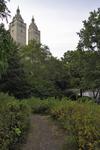 |
Strawberry Fields - not part of the Ramble but an excellent birding location in its own right. South-west of the Ramble on the far western shore of the Lake. I mention it elsewhere. |
The Central Park Conservancy's Ramble site gives fairly minimal information, but one of the more interesting things in the right side-bar is their description of past, current and future plans for restoration work in the Ramble. The Woodlands Committee of the Conservancy has been pretty good at responding to birder concerns in the last few years, and have done a lot of beneficial habitat restoration (that around the Azalea Pond is a good example) - although not everything is of benefit to the bird(ers) since the ground cover has been removed at the north end of Mugger's Woods around the Humming Tombstone in an area previously favored by Hooded Warbler.